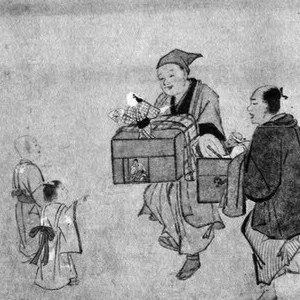Analyzing Primary Sources on the History of Children & Youth
Overview
How do you study the history of young people? What can primary source documents reveal? What limitations do they pose? What light can the history of young people shed on the past? This essay aims to serve as a guide to finding, interpreting or “reading” primary sources on young people from ancient civilizations to the present.
Essay
Children spring into view in this 18th-century Japanese ink painting by Hanabusa Itchô. In the painting’s details are seemingly happy children energetically running to see a traveling entertainer’s puppet show. One might assume from this painting, as did Harvard Zoologist Edward Sylvester Morse, that Japan was a children’s "paradise" where babies benefited from riding on the backs of older children instead of crying in their cribs. Yet probing beneath the surface of this source complicates this rosy picture of the past. A consideration of the age, gender, and class of the children reveal that the half-hidden figures in the window were upper-class girls prevented from playing on the streets. Although the painting portrays the children below as joyful, these komori (babysitters) who provided childcare in exchange for room and board often felt deep despair. While Confucian treatises on education, health, and wet-nursing are sources that reveal nothing about those from the lowest rung of society, other evidence—such as the songs sung by the komori—document more distress than delight. Knowing how to reexamine established assumptions, consider multiple perspectives, and make connections between inquiry and interpretation is essential to researching the history of children and youth. Critical to that endeavor is the skillful utilization of primary sources (original records created during a period under study or produced by a participant later on) that have survived from the past). How do you study the history of young people? What can primary source documents reveal? What limitations do they pose? What light can the history of young people shed on the past? This essay aims to serve as a guide to finding, interpreting or “reading” primary sources on young people from ancient civilizations to the present.
Primary Sources
Credits
Dr. Forman-Brunell is a native New Yorker who earned her M.A. in Women's History from Sarah Lawrence College (1982) and a Ph.D. in U.S. History from Rutgers University (1990). Before joining the UMKC History Department, she taught at Princeton University and Wellesley College. Her research has been supported by grants and fellowships from the NEH, Woodrow Wilson Foundation, Smithsonian, Schlesinger Library, etc. She is Co-Director of Children & Youth in History, an NEH-funded online resource co-produced by the Roy Rosenzweig Center for New Media at George Mason University where she is also Affiliated Faculty. Forman-Brunell is on the editorial board of five journals, the executive board of Girl Museum, and is co-chair of The Girls' History and Culture Network.
